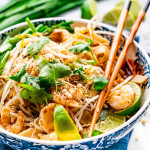Pad Thai
This Pad Thai with shrimp and tofu gives you all the flavors and taste of the authentic Pad Thai, in the comfort of your own home. Who needs takeout when you can do this in less than 30 minutes!
Servings: 4
Calories: 618kcal
Equipment
Ingredients
For Sauce
- 2 tablespoon brown sugar
- ¼ cup tamarind paste
- 2 tablespoon fish sauce
- 3 tablespoon water
Pad Thai
- 6 ounce rice noodles
- 2 medium shallots minced
- 3 cloves garlic minced
- 2 tablespoon dried shrimp rinsed and chopped
- 2 tablespoon sweet Daikon radishes chopped
- 8 ounce firm tofu cut into small pieces
- 1 tablespoon Sriracha sauce
- 1 cup fresh bean sprouts
- 1 cup Chinese chives (or garlic chives)
- ¼ cup roasted peanuts finely chopped
- 2 to 3 tablespoon peanut oil
- 1 pound shrimp shells removed and deveined if needed
- 2 eggs
Additional Toppings
- 1 cup fresh bean sprouts
- 1 cup Chinese chives
- ¼ cup roasted peanuts chopped
- lime wedges
- 2 tablespoon fresh cilantro (optional)
- Sriracha sauce
Instructions
- Prepare the rice noodles: Place noodles in a large bowl. Add enough cold water to cover them and let them rest for 1 hour or until noodles are pliable but not soft. Drain well in a colander. They will change color from translucent to white.
- Assemble the ingredients: In a small bowl whisk all the sauce ingredients together and set aside. In a bowl combine the shallots, garlic, dried shrimp, radishes, tofu and Sriracha. In another bowl combine the bean sprouts, chives, and ¼ cup of the peanuts.
- Cook the shrimp: In a medium skillet heat 1 tbsp of peanut oil over high heat. Add the shrimp and cook and stir about 1 to 2 minutes or until shrimp turns pink and starts to slightly char. Transfer to a bowl. Add the rest of the oil to the skillet or wok.
- Build the base: Add the rest of the oil to the skillet or wok. Add the tofu mixture to the skillet and saute for about minute. Add the noodles and sauce to the wok and toss everything. There is water in the sauce so the noodles will cook and absorb the liquid.
- Scramble the eggs: Move the noodles to the side of the wok and add the egg and break the yolks. Add a bit more oil if necessary before adding the eggs. Let them cook for 30 seconds then scramble them. Toss everything together.
- Finish the Pad Thai: Add the bean sprouts and chives mixture to the skillet and toss everything. Turn off the heat.
- Serving Pad Thai properly: To serve divide noodles mixture among 2 or 4 plates, depending on the size of the meal you want. Top with shrimp then sprinkle each serving with bean sprouts, extra chives, peanuts and lime wedges. Serve with fresh cilantro and Sriracha on the side.
Video
Notes
- Tamarind paste is a common ingredient used throughout the world. The paste is prepared from tamarind, which is a sticky sour tasting fruit that grows on bean-like pods on tamarind trees. Tamarind paste is both sweet and sour so I would substitute it with equal amounts of lime juice and brown sugar.
- Chinese chives (or garlic chives) look like regular chives but much bigger and leafier. They could be considered more vegetable rather than garnish. They are garlicky in flavor, juice and crisp in texture. Look for these chives in Asian markets. They can be substituted with regular chives or scallions.
- Dried shrimp are shrimp that have been sun-dried and shrunk to a small size. They are used in a lot of Asian dishes and give a unique umami taste. They can be found in Asian markets. Shrimp pastes can be substituted for dried shrimp.
- It's important to read the recipe once or twice before giving this recipe a go. As mentioned above, prepping all your ingredients first is the key to making a successful Pad Thai.
- Use a wok for best results. However a skillet will work as well.
- Feel free to switch up proteins. While I used shrimp and tofu, you can use chicken, beef, or even pork. The only thing I recommend is to cut them up in thin slices, for fast cooking.
- This Pad Thai will keep for 3 - 4 days in the fridge if stored in an airtight container. I wouldn't recommend freezing this dish as the egg and rice noodles don't thaw well after time in the freezer.
Nutrition
Serving: 1serving | Calories: 618kcal | Carbohydrates: 58g | Protein: 47g | Fat: 23g | Saturated Fat: 4g | Cholesterol: 452mg | Sodium: 2137mg | Potassium: 553mg | Fiber: 5g | Sugar: 14g | Vitamin A: 1003IU | Vitamin C: 29mg | Calcium: 351mg | Iron: 6mg
